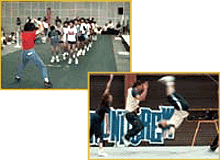JUMP ROPES TAKE OFF:
Traditional Kids' Play Finds New Popularity
April 10, 2001
|
 |
|
A line of children (top) prepare to jump a long rope. Professional rope jumpers (bottom) have been giving demonstrations at schools nationwide. (Bandai)
|
Many people think of jump rope as being nothing more than kids' play. But rope skipping is beginning to achieve recognition as a serious sport in Japan. In addition to releasing a line of jump ropes for everyone from small children to serious competitors, a major toy manufacturer has organized jump-rope classes all across Japan and is sponsoring tournaments, fueling the boom.
Booming Sales
Toy maker Bandai released the J Rope, a jump rope with roller bearings to make swinging easier, in fall 1999. The standard J Rope with plastic bearings connecting the rope and the handles costs 1,480 yen (12.33 U.S. dollars at 120 yen to the dollar). In addition, Bandai offers a model aimed at small children for 950 yen (7.91 dollars), one that can be used even by world-class competitors for 2,500 yen (20.83 dollars), and one with metal bearings that make it easy to twirl quickly for 3,500 yen (29.17 dollars).
With the aim of increasing the sales of its products, Bandai has held jump-rope classes all over Japan and has begun sponsoring competitions aimed at elementary school students. Between September 1999 and March 2001, Bandai held about 250 classes, which teach various techniques and tricks, attracting approximately 100,000 young participants.
Bandai began sponsoring jump-rope tournaments last year. Regional qualifying tournaments were held at 11 locations across Japan, followed by a national championship at Tokyo's Ryogoku Kokugikan, an arena used for sumo. Is this strategy working? Bandai sold one million jump ropes last year in a country where the overall demand is estimated to be about 7 million per year, making J Rope a huge hit. Sporting goods makers Asics and Mizuno have also put their energy into manufacturing and selling competition-level jump ropes, lending momentum to the spread of rope skipping as a legitimate sport.
Popular for Fitness
Jump rope has long been a popular form of recreation for children, but it was developed into a competitive sport in the 1980s by Richard Cendali, a physical education instructor in the United States who developed various moves. Since then the popularity of rope skipping has spread througout the world, and now international competitions are being held and records being kept. Although it is a young sport, the complexity of some of the maneuvers that have been developed has raised interest. In addition, it has become popular in many countries as a method of shaping up or maintaining fitness. It can even be continued into old age.
As the number of people who attempt competitive rope skipping continues to grow, the level of competition continues to rise. Japan currently boasts the athlete ranked number one in the world by the International Nawatobi (jump rope) Federation, Yuya Kiuchi of Ashiya City in Hyogo Prefecture. Meanwhile, jumping rope just for fun is not limited to young children. Its spreading popularity can be seen by the growing number of women enjoying the activity in sports clubs.
Back to Main Index
 Copyright (c) 2001 Japan Information Network. Edited by Japan Echo Inc. based on domestic Japanese news sources. Articles presented here are offered for reference purposes and do not necessarily represent the policy or views of the Japanese Government. Copyright (c) 2001 Japan Information Network. Edited by Japan Echo Inc. based on domestic Japanese news sources. Articles presented here are offered for reference purposes and do not necessarily represent the policy or views of the Japanese Government.
|



















